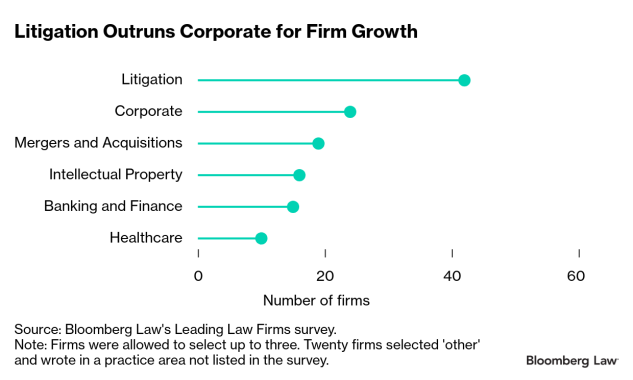- Litigation gives mid-size firms an edge over elites
- “Recession-proof” reputation, idealistic JDs fuel growth
On a recent Monday, the database Firm Prospects showed 685 corporate law job postings across the country for laterals thinking of making a move.
Litigation jobs? 1,861 postings.
“That’s not what one would expect in precedented times,” said Kate Reder Sheikh, a partner at legal recruiter Major Lindsey & Africa. But economic uncertainty has created “a witch’s brew that’s not fertile for most M&A practices, while litigation keeps on churning regardless.”
That demand for litigators dominated Bloomberg Law’s Leading Law Firms data—with industry professionals attributing it to litigation’s “recession-proof” reputation, growing prestige, and third-party cash flow.
Litigation leads other practices as the target growth area among the nearly 100 firms surveyed. Forty-two firms said they’re expanding in litigation, compared to 24 growing in corporate law, and 19 in mergers and acquisitions.
Read more: See which firms came out on top overall in Bloomberg Law’s Leading Law Firms.
To be sure, corporate and M&A can be grouped broadly as transactional law and still hold strong as a growth target for firms. Elite firms like Kirkland & Ellis still tout private equity, M&A, and corporate restructuring among their top areas. And stars of transactional law like Paul, Weiss’ corporate chair Scott Barshay are envied in the industry for bringing home more money than bankers and pro athletes.
But the tide of growth is shifting, particularly for mid-size firms outside Wall Street-centric New York City, said partners, recruiters, and business-of-law analysts. For those firms, which struggle to compete with top dealmakers, litigation is an opportunity to carve their own space in an area clients increasingly emphasize.
“In a polarized political environment, clients feel litigation can have more visibility,” leading them to value it more, said Pat Whalen, the Kansas City-based chair and managing partner at Spencer Fane, a firm that has seen its revenue rocket over the past five years.
“What I heard for decades was transactional practices generate litigation work,” Whalen said. “But we see our litigators spinning off transactional work at a significant clip.”
Attorneys pointed to a range of factors for targeting litigation as a growth area, with macro-economics at the top.
Litigation is “recession-proof,” said Mark Hendricks, a managing partner at Florida-based mid-size firm Lydecker LLP. His firm has expanded in states like Georgia, California, and Texas over the past decade on the back of defense-side litigation in areas like toxic torts, he said.
Litigation withstands—or grows in—anxious times, Hendricks said. He recounted the litany of disasters that led to more work. The 2008 crash? Suits against banks, appraisers, and brokers. The Surfside condo collapse? Litigation against developers. The discovery of links between exposure to hazardous material and disease? Suits against employers and product manufacturers.
Even during the height of the Covid pandemic, business didn’t slow as insurance companies faced suits, Hendricks said. “Personally I feel there’s too much litigation,” he said.
W. Jan Pietruszka, labor and employment lead at Shumaker, Loop & Kendrick, an Ohio-based mid-size firm, said his practice area also sees a litigation uptick in hard times: “When the economy is down employee layoffs lead to increased employment law litigation.”
For mid-size firms a litigation focus may offer an edge against Big Law and boutiques.
“The mid-size firms have been getting crushed,” said Yale Law professor John Morley.
Big Law—because of its scale—can offer clients “exactly the right kind of lawyer for exactly their transaction.” Boutiques can specialize in niche transactional issues like private funds.
“Litigation is a better way for mid-size firms to compete,” Morley said.
Veteran legal recruiter Jon Truster of Macrae said the rise in litigation funding may also fuel a litigation growth spurt, giving more plaintiffs the resources to go to trial. Litigation funders like Burford Capital and Fortress have poured billions into lawsuits over the past decade.
Then there are the newly minted JDs who’ve added to an uptick in law school applications over the past decade—a so-called “Trump bump” from aspiring attorneys who want to fight for liberal causes. Now they’ve graduated.
“Law grads probably for idealistic reasons would rather be litigators,” Truster said.
To contact the reporter on this story:
To contact the editor responsible for this story:
Learn more about Bloomberg Law or Log In to keep reading:
See Breaking News in Context
Bloomberg Law provides trusted coverage of current events enhanced with legal analysis.
Already a subscriber?
Log in to keep reading or access research tools and resources.


